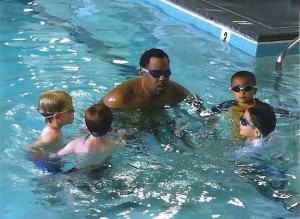Pasadena, California Sep 30, 2021 (Issuewire.com) - Summertime may be officially over but the aquatic fun doesn't end especially in Southern California, which has an abundance of beaches and lakes. Additionally, the Los Angeles County Department of Parks and Recreation boasts 30 swimming pools, 23 splash pads, and 5 wading pools for the public to enjoy water aerobics and exercise to playing water polo. However, with the new COVID-19 variants on the rise, is it safe to go back into the water?
While there is no scientific evidence that the coronavirus can be transmitted in bodies of water, a pool, hot tub, or water park, the Centers for Disease Control and Prevention offer tips to lower the risk of being infected by the virus when enjoying indoor and outdoor aquatic fun. Check the County’s site for COVID-19 updates about amenities open to the public.
“The primary spread in these environments would be by close proximity of individuals, which is often encountered during swim lessons, recreational, or exercise activities,” said Bobby Broome, the owner of Bobby Broome Aquatics and author of, The Parent's Guide To Water Safety And Swim Instruction and Learn to Swim In 8 Lessons or Less. “COVID-19 has not been detected in chlorinated pool water. Those chemicals kill most pathogens and it has not been detected in salt water or fresh water.” It is important to note that outdoor activities are much safer than indoor activities. Fully vaccinated individuals have a lowered risk than those who have had one shot or none at all.
To maximize safety measures, CDC recommended tips include to shower and dress in swimwear at home before arriving at the aquatic facility; wear a cloth mask but not in the water; however, bring an additional mask in case it gets wet; and stay 6 feet apart from others while in any body of water.
The coronavirus is not the only concern when in or near a body of water. The grim statistics as cited by the CDC and other organizations state that there are an estimated 320,000 annual drowning deaths worldwide and drowning is the 3rd leading cause of unintentional injury death worldwide. Yet, people are hesitant to learn to swim. The American Academy of Pediatrics recommends swimming lessons begin at four years old.
According to the CDC, in the United States, nearly 4,000 persons die from drowning annually, and drowning is responsible for more deaths among children aged 1–4 years than any other cause except congenital anomalies. Swimming pool drowning rates are among Blacks aged 5–19 years 5.5 times higher than whites in the same age group. Drowning is the cause of death for most boating fatalities. Children younger than one-year-old are more likely to drown at home or children 5 years old and younger in hot tubs.
Broome is on a mission to change the narrative about the fear of water and the benefits of learning to swim. "I take my life-saving swimming skills to communities across the Nation," he said. He believes in saving lives one person at a time by teaching swimming and safety techniques to individuals from 6 months old to the elderly.
“I learned to swim at the age of 5,” said Broome who has American Red Cross certifications and certifies hundreds of lifeguards annually. “I consider myself a YMCA baby because I learned to swim at the YMCA and at 11 years old, I entered the Junior Lifeguard program. My first job was as a lifeguard at the beach in Chicago on Lake Michigan. Aquatics was always a part of my life’s plan.” Broome moved to Los Angeles to pursue a career in the entertainment industry. “When I became a single dad, I changed careers to aquatic training to allow me to spend quality time with my daughter.” Broome found his true purpose.
“As a Black man, I didn’t see many BIPOC men, women, teens, and children who are taking swimming lessons or consider a career in aquatics,” said Broome. “I believe if we see more people who look like us in the community and enjoying the benefits of water activities, we can widen our horizons and be more adventurous in the water.”
From experience, he learned that in general people hesitate to learn to swim primarily because of fear. “I break down fear into three categories: real, perceived, and manufactured. The real fear is fear that is learned from parents, caregivers, friends, and associations. The real fear is learned from bad experiences such as, near drowning or simply getting too much water in the nose initially during the learning process,” he said. “Perceived fear is fear of the unknown. Easier to overcome. Manufactured fear is a combination of real fear and a complete lack of desire or readiness. The learner convinces themselves to be afraid.”
Aside from acquiring survival skills in the water, Broome says some of the benefits to learning to swim are, “Knowing how to swim makes you less likely to drown in aquatic environments, makes it possible to enjoy leisurely and recreational activities and exercise in aquatic environments, and builds general confidence of one’s ability to overcome fear and to try new things.”
Studies revealed that swimming was not a part of African American's recreational culture as a result of discrimination and segregation at public pools and generational fear. Nearly 70 percent of African Americans don't know how to swim.
“Typically, parents who have no or minimal swimming skills, their children are unlikely to know how to swim,” said Broome. “It is satisfying to see my students learn to swim. For me, it is 10 times more satisfying to watch my students with cognitive disabilities and regular disabilities such as visually impaired or hearing impaired or physically impaired, but cognitive issues such as autism or Down syndrome, become swimmers.”
One of Broome’s best achievements happened when he was hired by the parents of a six-year-old boy who had tactile and autistic issues. “They wanted their son to enjoy some form of physical activities but he was not able to put anything over his head, not even a shirt. He used to wear button-down shirts because things going over his head would really freak him out,” said Broome. “I was determined to teach him how to swim. Because he would not put his head in the water, I taught him how to swim with his head out of the water, which is something I never do.”
Not one to give up, Broome was patient. “It took a long time and over time, he eventually started putting his face in the water and is now a strong swimmer. He still comes to me for swim lessons because I think it is part of his therapy.” The boy is now a 17-year-old young man.
“Learning to swim is a great survival skill to master but I put emphasis on good swimming and water safety habits to prevent an increase in drowning statistics and avoidable water accidents,” said Broome who for more than 12 years travels from the East Coast to the City of Pasadena Parks, Recreation and Community Service every summer to provide in-service training for 40 to 50 lifeguards and swim instructors.
“My goal is that all Black children learn to swim,” said Darrell Walker, the City of Pasadena Parks, Recreation, and Community Service Superintendent for 31 years and oversees various programs including aquatics. “It is important for them to learn the proper way to swim and water safety techniques.” Walker has been on board the Rose Bowl Aquatics Center for seven years.
The Los Angeles County of Parks and Recreation offers a comprehensive Lifeguard Ready Training program for ages 16- 24 to prepare them to become Los Angeles County Pool Lifeguard. The first session started on September 27. To find the locations, months/days, and hours of operation for pools, splash pads, and wading pools, go to https://parks.lacounty.gov/ and click on aquatics.
Media Contact
Marie Lemelle MarieLemelle@platinumstarmediagroup.com 3238539035 http://www.platinumstarmediagroup.com









